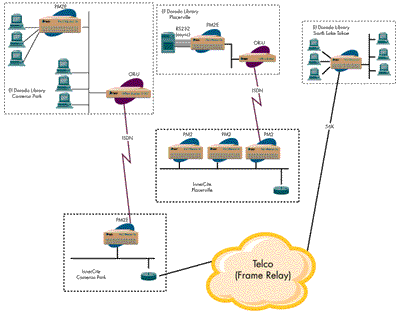El Dorado Case Study
Background
It was in El Dorado County, California, where John Marshall made the discovery that touched off the great Gold Rush of 1849. In recent years, that picturesque area of the State has become a favorite of vacationers and retirees seeking escape from the Bay Area and Sacramento urban sprawl. This trend is reflected in the rapid growth of the El Dorado County Library system, which now includes a central library in Placerville, the County Seat, and five branch libraries in South Lake Tahoe, Pollock Pines, Georgetown, Cameron Park, and El Dorado Hills.
In 1990, the County Library entered the Information Age by purchasing an HP-3000 mainframe which was installed at its location in Placerville. Dumb terminals and statistical multiplexers were used to connect the branch libraries to this mainframe via analog lines.
By the time its newest and largest Cameron Park branch library opened in 1994, the demand for Internet access had increased dramatically throughout El Dorado County. So, in 1995, the Cameron Park and Placerville branches began offering Internet access to their card-holders via dial-up connections to InnerCite, a Cameron Park-based Internet service provider (ISP).
Limited Resources
Like most public libraries, the El Dorado system operates on a very limited annual budget. In planning their network to minimize cost, the Library administration sought the advice of Lloyd Internetworking, then an independent software developer based in Cameron Park and now part of Lucent Technologies InterNetworking Systems.
Costly Telco Connections
Brian Lloyd, founding president of Lloyd Internetworking, suggested an all-digital solution, using Lucent Technologies PortMaster® series of InterNetworking Systems servers and office routers. "We found that paying the $220 monthly fee for a statistical multiplexed connection to the Internet would be cost prohibitive," explains Gary Parks, Digital Systems Coordinator for the El Dorado libraries. "And when Brian showed us there was a way to consolidate all our analog lines by going digital through the use of ISDN and a frame relay connection for South Lake Tahoe that cost only $90 a month, our course of action was clear."
Solution
In addition to controlling costs, the El Dorado Libraries had to consider the limited computer skills of most of its card-holder users. Brian recommended the PortMaster 2E, which is a modular communications server capable of supporting from 10 to 30 dial-up connections along with a single T1/E1 synchronous WAN port for frame relay. "By installing PortMaster 2Es at key locations," Brian explains, "the Libraries were able to use the same links to connect their remote dumb terminals to the HP3000 mainframe in Placerville and to support Internet access for their cardholders, thus reducing line costs while improving service." The Figure shows the specific network design Brian proposed.

Results
A visit to their home page at www.el-dorado.ca.us reveals that, despite budgetary constraints, the El Dorado library system has made significant steps toward its goal of becoming a full-service and Internet-connected public facility. Four PCs with Internet access will soon be added to the Placerville branch, and the Georgetown and Pollack Hills branches may use the serial port on the Office Router to provide a Telnet connection to the HP3000 via the PortMaster 2E at the Main library.
"All of this networking change," explains Gary Parks, "lays the groundwork for our switching all our branches to a new client-server system by 1999. Lucent Technologies products and technical expertise are making it possible for us to build a single network for mainframe and Internet access. Special credit goes to Brian Lloyd who has spent many hours helping us with the architecture of our system. The PortMasters have worked extremely reliably. We couldn't be happier."